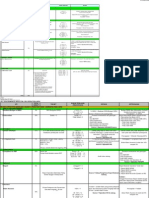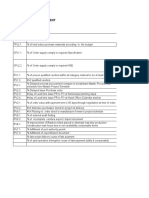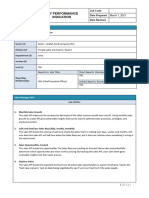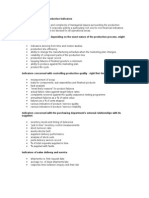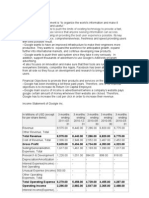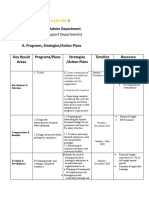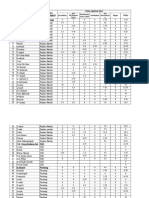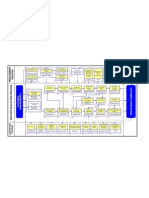KPI
KPI
Uploaded by
Adnan AslamCopyright:
Available Formats
KPI
KPI
Uploaded by
Adnan AslamOriginal Description:
Copyright
Available Formats
Share this document
Did you find this document useful?
Is this content inappropriate?
Copyright:
Available Formats
KPI
KPI
Uploaded by
Adnan AslamCopyright:
Available Formats
Key Performance Indicators
Page 1
Key Performance Indicators KPI Background The term KPI has become one of the most over-used and little understood terms in business development and management. In theory it provides a series of measures against which internal managers and external investors can judge the business and how it is likely to perform over the medium and long term. Regrettably it has become confused with metrics if we can measure it, it is a KPI. Against the growing background of noise created by a welter of such KPI concepts, the true value of the core KPI becomes lost. The KPI when properly developed should be provide all staff with clear goals and objectives, coupled with an understanding of how they relate to the overall success of the organisation. Published internally and continually referred to, they will also strengthen shared values and create common goals. What are the key components of a KPI? The KPI should be seen as: Only Key when it is of fundamental importance in gaining competitive advantage and is a make or break component in the success or failure of the enterprise. For example, the level of labour turnover is an important operating ratio, but rarely one that is a make or break element in the success and failure of the organisation. Many are able to operate on well below benchmark levels and still return satisfactory or above satisfactory results. Only relating to Performance when it can be clearly measured, quantified and easily influenced by the organisation. For example, weather influences many tourist related operations but the organisation cannot influence the weather. Sales growth may be an important performance criteria but targets must be set that can be measured. Only an Indicator if it provides leading information on future performance. A considerable amount of data within the organisation only has value for historical purposes for example debtor and creditor length. By contrast rates of new product development provide excellent leading edge information. Obviously KPI's cannot operate in a vacuum. One cannot establish a KPI without a clear understanding of what is possible so we have to be able to set upper and lower limits of the KPI in reference to the market and how the competition is performing (or in the absence of competition, a comparable measurement from a number of similar organisations). This means that an understanding of benchmarks is essential to make KPI's useful (and specific to the organisation), as they put the level of current performance in context both for start ups and established enterprises though they are more important for the latter. Benchmarks also help in checking what other successful organisations see as crucial in building and maintaining competitive advantage, as they are central to any type of competitive analysis. Start with what you need to measure and monitor Different organisations need to monitor different aspects of their environment. For example, the airline industry has a complex set of issues many of which (but not all) are different from the dairy farmer. Ibis has created a number of separate business monitoring modules for medium sized companies which we believe cover the majority of requirements for the development and maintenance of their organisation, that are part of a bottom up planning system based around knowledge centres. For the typical medium enterprise, 80 monitoring elements are part of the standard Ibis kit which is initially proposed during the introduction of knowledge centers. This kit provides a rapid introduction of the key monitoring components. These are the key components of the range of monitoring elements that can be considered in the accompanying table below. Knowledge centre Administration Focus of activity Leadership, planning and monitoring, balanced scorecard, budgeting, portfolio theory, golden circle, decision making, creativity, SCORE, corporate governance, territorial imperative, Possible KPI PEST elements, budget ratio, high impact/ high probability assumptions and boundary conditions (strategic risk 1/22/2013 3:05:22 PM
http://www.ibisassoc.co.uk/key-performance-indicators.htm
Key Performance Indicators impact analysis, standard operating procedures, mosaic management, prioritisation, trade offs, MBO, succession planning, quality circles, technology audit, vision statement, SBU decisions, Abacus principle, time keeping,barriers to entry, critical success factors, business model, legacy issues, successes failures/ lessons learnt, authority/ responsibility, recruitment appraisal, acquisitions, cascade investment, disposals, premises review, stakeholder relationships, trade associations, synergy, recruitment appraisal, risk management, planning effectiveness, legal, health and safety, SBS, utilities, insurance, security, design for operating efficiency, time study, complaints, pensions, share options, employee share savings schemes, creativity, fringe benefits, bonus systems,secrecy, meeting management, time management, cost cutting, facilities management, stress, forecast grid, trade offs, communication, investment appraisal, health and safety, environmental audit, ISO 9000, ISO 14000, operating financial review (OFR), working conditions, employee suggestion, team building, training, internal service satisfaction Finance Planning and monitoring, balanced scorecard, budgeting, cash flow, profit and loss, balance sheet, successes failures/ lessons learnt, trade offs, MBO, mosaic management, prioritisation, IFRS, GAAP, succession planning, accounting assumptions, technology audit, SCORE, decision making, creativity, quality circles, asset register, invoicing,profitability, activity, and liquidity ratios, revaluation accounting, fraud, capital allocation profile, James' rule, contingent liabilities, deferred consideration, cost capitalisation, brand accounting, cost cutting, payment systems, trade offs, documentary credits, time keeping, dividend policy, cash management, currency management, sales tax, depreciation, synergy, recruitment appraisal, funding options, financial reporting, audit, cascade investment, recruitment appraisal, source and application of funds, sensitivity analysis, investment appraisal, convertibles, tax management, credit management, hedging, team building, time management,training, internal service satisfaction Planning and monitoring, balanced scorecard , budgeting, portfolio analysis, trade offs, MBO, successes assessment),CGAL, RSM, contractual, portfolio risk levels, % hurdle rate, insurance costs/sales, BEV, capital spread ratio, cost per sqm or cost per employee for facilities total space, productive hours %, % meeting time, BS index, utility cost, noise, accidents, % outsourcing, complaint resolution speed, complaint resolution cost, average meetings/ month, utility cost/ market cost ratio, premises cost/ market cost ratio, space utilisation, whistleblowing, temperature, noise, health and safety breaches, security breaches, document loss, pension cost, theft, AER, budget ratio, KFR, project success, certification, wages ratio, litigation, internal service satisfaction levels, effective headcount, % mentoring, risk profile.
Page 2
Financial ratios, budget ratio, % outsourcing, FER, BEV, BEV/EBITDA, debt age, cost of finance, capital allocation ratio, capex, EFT%, CER, tax charge, SPT %, gross yield, P/E,PEG, EPS, project success, DER%, BDR, FCF, overdue accounts, productive hours %, market dynamics capital allocation, EBITDA currency/ debt currency ratio, sales tax rate %, cash interest rate%, depreciation %, internal service satisfaction levels, effective headcount, % mentoring, forecast error, risk profile, average project IRR return
Marketing/ sales
CLV, budget ratio, market share by segment, trial rate, competitive score,
http://www.ibisassoc.co.uk/key-performance-indicators.htm
1/22/2013 3:05:22 PM
Key Performance Indicators failures/ lessons learnt, succession planning, recruitment appraisal, mosaic management, prioritisation, technology audit, SCORE, decision making, creativity, market drivers, marketing mix, branding, Single Block Theory, entrants, substitutes, market research, customer panel, sales channels, distribution channels, sales management,investment appraisal, call centres, marginal profitability, quality circles, customer loss, products/ services (width/depth), cross selling, value chain, expectation fulfillment gap, market size, customer transition, seasonality, networking, price elasticity,cascade investment, pricing terms and conditions, quantitative analysis, customer satisfaction, reference sale, time keeping, synergy, pricing power, cost cutting, market spread, customer investment review (CIR), marketing myopia, product age spread, organisational buyer behaviour, reference sale, customer spread, product age, competitive advantage, competitive bidding, trade offs, negotiation, recruitment appraisal, game theory, channel management, customer care, complaints, warranties, mystery shopper, time management, branding, team building, training, internal service satisfaction sales by channel, % repeat purchase, average sales value, sales productivity, market share, advertising productivity by channel, cost per lead, cost per converted lead, bid success rates, range sale%, average discount, service call out times, productive hours %, enquiry response time, seasonality ratio, price index, customer satisfaction, advertising awareness, % branding % , customer investment review, customer transition rate, value chain, % outsourcing, MER, budget ratio, EGMG ratio, customer investment return, customer churn, complaints, warranty claims, project success, channel members, product positioning variance, SER, AER, pricing, price elasticity, country spread, seasonality ratio, customer spread, product spread, product age spread ratios, segmental leadership, TDA's, project success, CIR%, competitive bidding success %, internal service satisfaction levels, effective headcount, % mentoring, forecast error, risk profile, project IRR return. Cost variances, budget ratio,order processing cycle, production cycle times, downtime, % outsourcing, PLER, budget ratio, STR, capacity utilisation, logistics cost, SPC, load utilisation, failure rates, return on plant, space utilisation, set up time, waste rates, pollution levels, emergency delivery, out of stock %, obsolescent stock %, recycling%, back order %, JIT% energy efficiency ratio, peak capacity %, supplier ratio, partnering, obsolescent stock, EOQ, number of suppliers, supplier spread ratio, number of components,
Page 3
Production/logistics/ service delivery
Planning and monitoring, balanced scorecard, budgeting, successes failures/ lessons learnt, standard costing, activity based costing, trade offs, MBO, succession planning, mosaic management, prioritisation, investment appraisal, design for operating efficiency, JIT, FMS,technology audit, SCORE including cost cutting, decision making, creativity,production efficiencies, PLM, aggregate demand policy, synergy, management accounting, OR, suppliers, supply chain management, MRP, backorder, time keeping, inventory levels, production equipment age, quantitative analysis, design, sophistication, capacity, TQM, TPM, waste management, condition monitoring, recycling, complaints, technical support, recruitment appraisal, distant data capture, distribution structure (warehousing,
http://www.ibisassoc.co.uk/key-performance-indicators.htm
1/22/2013 3:05:22 PM
Key Performance Indicators outlet location) and physical distribution management, obsolescent stock, cascade investment, time based competition, time management, quality circles, order processing, trade offs, scheduling, purchasing, recruitment appraisal, vendor ranking, networking, postponement, standardization, product/ service design, team building, training,internal service satisfaction Personnel Planning and monitoring, balanced scorecard, budgeting, successes failures/ lessons learnt, trade offs, MBO, succession planning, mosaic management, prioritisation, quality circles, Noah principle, decision making, creativity, technology audit, SCORE, eight "S", absenteeism, timekeeping, trade offs, overtime, industrial relations, stress, bonus systems, training needs analysis, time keeping, recruitment appraisal, time management, team building, cost cutting, cascade investment,wages, employee record keeping, synergy, vacation planning, training, internal service satisfaction emergency call out, delivery failures, productive hours %, Eenablement, vendor rating, project success, internal service satisfaction levels, effective headcount, % mentoring, forecast error, risk profile, joint planning ratio, project IRR return. Productivity, budget ratio,turnover, absenteeism, % outsourcing (temporary staff ratio), PER, budget ratio, labour cost%, wages ratio, CNCER, employee satisfaction levels, CH/ WH ratio, overtime%, skills, training, discipline, disputes, appeals, timekeeping ratio, apprenticeship, recruitment costs, training days,productive hours %, whistleblowing, span of control, appraisals, wages ratio, diversity index, PDP, project success, internal service satisfaction levels, effective headcount, % mentoring, risk profile. Management information system functionality,productivity, budget ratio,stability, web hits, access speed, site downtime, site click through, productive hours %, Intranet, Extranet, % outsourcing, ITER, budget ratio, security breaches, data storage, EDI, web position, quality of data, information overload, project success, internal service satisfaction levels, effective headcount, % mentoring, software aligment ratio, Eenablement ratio, risk profile
Page 4
IT
Planning and monitoring, balanced scorecard , budgeting,successes failures/ lessons learnt, trade offs, MBO, investment appraisal, succession planning, mosaic management, prioritisation, data mining, technology audit, SCORE, decision making, creativity, Intranet, Extranet, trade offs, telecommunications and IT platform, management information systems (MIS), web design and management, cloud computing, systems, time management, synergy, recruitment appraisal, SEO, information flow map, security,mystery shopper, teleworking, cascade investment,quantitative analysis, cost cutting, time keeping, systems analysis, team building, training, artificial intelligence, quantitative analysis, modeling, encryption, recruitment appraisal, internal service satisfaction, software alignment, E-enablement. Planning and monitoring, budgeting,innovation matrix, balanced scorecard, mosaic management, prioritisation, successes failures/ lessons learnt, trade offs, MBO, succession planning,investment appraisal, TBC, technology audit, SCORE, quality circles, decision
Product/ service development
Product age spread, R&D %,ideas, strategic fit, budget ratio, protocol score, total cycle time, project review, team creation, testing, % outsourcing, NPDER, budget ratio, license fees,
http://www.ibisassoc.co.uk/key-performance-indicators.htm
1/22/2013 3:05:22 PM
Key Performance Indicators making, recruitment appraisal, creativity, product age profile, period of grace, trade offs, halo effect, identification of new product/ service concepts, synergy, cannabilisation, protocol, IPLC, certification, cascade investment, technology transfer, first mover advantage, time management,recruitment appraisal, IPR, successful development/ commercialisation, team building, training,internal service satisfaction Contingency planning Authority and responsibility, planning and monitoring, budgeting, successes failures/ lessons learnt, creativity, SCORE, investment appraisal, assumptions, high risk/high probability, Black Swan theory, failure points, reducing potential for failure, setting trigger points, action plan, risk profile, stage gate, team building, communication, training, TEWT, simulations, role play, impact analysis Establish current performance, benchmark and target levels IPR%, IPR infringements, IPR maintenance costs, royalty rate %, time, productive hours %, budget, specification, project success, internal service satisfaction levels, effective headcount, % mentoring, forecast error, % NPD sales over three years, risk profile, project IRR return, reverse engineering Risk score, response times, budget ratio, KFR, % outsourcing, % SOP, % training, % above/below barrier conditions, success rates, % budget
Page 5
For each monitoring module, one can then establish what the current level of performance is in a measurable and understandable way. This is the current performance. From industry sources, the benchmark level can normally be introduced (getting to benchmarks is often a difficult process and one requiring a mixture of low cunning and/or sophisticated analysis). Then a target level of achievement can be entered. Let us take an example of a financial management module for an established manufacturing company and what it will tell us. Financial knowledge centre monitoring components Factor Gross profit % ROCE % FCF BEV/EBITDA Gearing (DER) Debt age (years) Interest cover X AER % SER % Debtor length (days) Creditor length (days) Stock turn/year Current ratio Budget ratio Capex ratio WCR Z score Tax charge % Depreciation % Cost of finance % EFT Overdue accounts % Current 68 13 12 0.2 15 8.5 8.3 8 10 102 60 5 4 95 8 1.7 3 12 15 3 82 2 Benchmark 52 10 n/a n/a 38 6.3 3.7 12 12 95 63 4 3 n/a 4 3.2 7 19 12 8 n/a n/a Target 72 20 10 0.2 15 10 10 6 6 60 60 8 4 n/a 7 1.7 3 10 n/a 3 88 1
http://www.ibisassoc.co.uk/key-performance-indicators.htm
1/22/2013 3:05:22 PM
Key Performance Indicators STP% FER% Project success ratio Internal satisfaction level % Effective headcount % 92 3 90 67 64 n/a n/a n/a n/a n/a 95 2.6 90 90 75
Page 6
We can gain an enormous amount of information and control from such a chart, but obviously not all components will meet the criteria of being a KPI otherwise we are back into the problem of measuring everything and not concentrating on a limited number of core criteria. Add KPI project control elements This ratio based analysis is combined with a review of individual projects normally based around the three key performance criteria, whether the project is on time, on budget and on specification. For projects involving significant expenditure the measurement of stage gate components will also significantly add to the level of control at a knowledge center level. An example from the same knowledge centre would look like this: Project Debt refinancing Tax review Sales insurance Due date August September August On time Yes Yes Yes On budget Yes Yes Yes On spec Yes Yes Yes Stage gate None None None
How do I use such a format to develop and understanding of what is a KPI? As different individuals and organisations will put a different emphasis on each item of information a definitive list of what is and what is not a KPI will depend on individual decisions, and will vary considerably according to the stage of company development. Start up enterprises need to place their emphasis on structural factors; established companies on operational performance. However, one can set some guidelines. The most rapid way to establish the KPI within any set of monitoring information is to work through the three criteria in sequence. Is the control information key to the success of the organisation? Can we measure it and influence it? Does it provide leading edge indications of future developments? Which measures in the above chart are key? Gross profit is one key measure to the success of the organisation. Research shows that survival rates are linked to levels of gross profit; gross profit margins above that of the competition provide clear evidence of competitive advantage. Return on capital employed is another key measure of the success of the organisation. The ability to use investment effectively is central to effective long term development. Z score is a measure of the liquidity of the enterprise and clearly defines positive or negative trends. It would be the Ibis argument that the other components of the chart are not key they are valuable items of information but are not make or break aspects of company management (unless they are grotesquely different from benchmark values). Are these performance measures can we quantify them and influence them? Yes Do these provide leading edge indications of future performance? Yes The conclusion from this analysis is that in financial reporting the company should concentrate on gross profit, return on capital employed and Z scores as their key performance indicators. Both gross profit
http://www.ibisassoc.co.uk/key-performance-indicators.htm
1/22/2013 3:05:22 PM
Key Performance Indicators
Page 7 and return on capital employed are part of the model balanced scorecard for overall objectives that Ibis propose for the majority of enterprises as part of their planning platform. Other components within the financial reporting module that might be considered as KPI's are factors such as the levels of gearing (debt/ equity ratio DER), project success rates, bad debt rates, and free cash flow (FCF). Including time, budget and specification to project reporting would also be a natural addition. The balanced scorecard and KPI's In addition to the creation of the enterprise balanced scorecard, in which gross profit, return on capital and Z scores are standard elements, the identification of KPI's in each of the operational areas or knowledge centres also assists the enterprise in plan development. These KPI's will change over time, but their creation as part of the initial creation of each knowledge centre will focus and direct their operational activities. The KPI and the information system KPIs significantly assist in the creation of an effective information system. Five different tranches of information with different times requirements should be considered within the well run enterprise to ensure that the all too common problem of information overload is reduced. They are: Ad hoc information requirements (for dealing with unforeseen changes in the environment an example would be recruitment appraisal); Weekly information requirements (for immediate control purposes an example would be cash flow); Monthly information requirements (for monitoring purposes an example would be budget and cost variances); Quarterly information requirements (for purposes of redirecting the enterprise within the overall plan an example would be the ideas day); Annual information requirements (for planning purposes an example would be econometric forecasting) KPIs when introduced into a monthly knowledge center based monitoring system become central to the understanding of organizational performance. KPIs when central to the monitoring system also drive software choices within each of the knowledge centers. Effective software alignment with knowledge centers and key performance indicators has been shown to have numerous benefits: Improving the quality of monitoring within the enterprise; Simplifying bottom up planning systems; Enhancing skills; Improving overall productivity; Improving team integration; Increasing the potential for management by objectives (MBO); Providing valuable structure for induction, maintenance and development training Where else are KPI's valuable? The KPI is central to a number of other elements in the planning platform which provides the basis for answering the three crucial planning questions: Where are we? Where do we want to be (and when)? How are we going to get there cost effectively?
http://www.ibisassoc.co.uk/key-performance-indicators.htm
1/22/2013 3:05:22 PM
Key Performance Indicators
Page 8 In addition to the creation of knowledge centres and business monitoring, KPI's have a vital role to play in: Action planning and implementation with an emphasis on management by objectives which will include a standardised rate of return and detailed project control; Training as part of a company-wide approach to focusing staff and management on essential operational requirements; Central to business planning as a core part of the business plan outline; Identification of necessary actions in change management, exit planning and survival and recovery planning; They set priorities for investment appraisal, and the choice of emphasis that should be given to the main strategies within the golden circle, consolidation (including cost cutting), market penetration, ,market development and product development. Training on key performance indicators, the creation of a business plan and standard operating procedures is available from Ibis. How can I get more information about how the KPI fits into the development of the business plan? Ibis has a number of "model" plans available. The plan for an established company, Castellan, is available in a summarized form as a download. Note that the KPIs chosen are not the complete list present in the full plan. More information on the way in which Ibis can contribute to your business plan development is provided at Advantage Ibis E-mail Ibis now. More information on the Ibis approach is also available on the FAQ page.. If you are an established business you can find an on-line quiz to analyse your business planning and control development HERE If you are a start up business you can find an on-line quiz to analyse your business planning and control development HERE If you are planning for high growth click HERE Business Plan SOP A comprehensive, easy to use 188 page manual containing scores of worksheets and notes. The contents follow the business plan outline, and have been rigorously tested during years of training throughout the world. The Ibis business plan manual is delivered in Word format, so that users can complete the worksheets and transfer them into the body of their own business plan.
[ Model Business Plan 1 ] [ Advantage Ibis ] [ Ten-Best-Investments ] [ F A Q ] [ Business Plan Outline ] [ Start Up Quiz ] [ Mentoring ] [ Business Plan Training ] [ Business Plan Game ] [ Entrepreneur's Quiz ] [ Business Concept Quiz ] [ Investment Case ] [ Start-up Analysis ] [ Established Business Quiz ] [ Effective Planning ] [ High Growth Plan ] [ Business Monitoring ] [ Virtual Office ] [ Operating Procedures ] [ K P I ] [ Contingency Planning ] [ Change Management ] [ Survival & Recovery ] [ Planning/Implementation ] [ Corporate Governance ] [ Risk Management ] [ Business Health Check ] [ Knowledge Centres ] [ Articles ] [ Exit Planning ] [ Cost Cutting ] [ Competitive Analysis ] [ Controversial Case ] [ Communication ] [ Business Model ] [ Profit Optimization ] [ Ibis Shop ] [ Other Useful Sites ] [ Site Map ]
14 November 2012 18:51:53 Ibis Associates European office La Vieille Loge, La Milliere, 86700, Romagne, Poitiers, France
http://www.ibisassoc.co.uk/key-performance-indicators.htm
1/22/2013 3:05:22 PM
Key Performance Indicators
Tel: 0033 (0) 5 49 87 80 76 E-Mail: Info@ibisassoc.co.uk
Site designed and maintained by Associate Internet Promotions 2012 Alan West All Rights Reserved
Page 9
http://www.ibisassoc.co.uk/key-performance-indicators.htm
1/22/2013 3:05:22 PM
You might also like
- Key Role Areas and Key Performance Indicators of Procurement ExecutiveDocument2 pagesKey Role Areas and Key Performance Indicators of Procurement ExecutiveDayal100% (20)
- Exhibit 3 - Search Fund Formation - Private Placement Memorandum (Sample)Document21 pagesExhibit 3 - Search Fund Formation - Private Placement Memorandum (Sample)Lior100% (1)
- Nedbank Investment Statement - 28 Oct 2023Document2 pagesNedbank Investment Statement - 28 Oct 2023mabuyisizakeleNo ratings yet
- KEPL MR 06 - Management Review MeetingDocument2 pagesKEPL MR 06 - Management Review MeetingAvijit Sen100% (1)
- KPI TableDocument29 pagesKPI TableCornel Monda100% (5)
- Matrix KPI 2011 - FinalDocument6 pagesMatrix KPI 2011 - FinalNurZalam Tato33% (3)
- KPI - ProcurementDocument11 pagesKPI - Procurementajaykg100% (2)
- Kpi Dashboard: Dept. KPI Target Jan FebDocument7 pagesKpi Dashboard: Dept. KPI Target Jan FebJomz100% (2)
- Presentasi Balanced ScorecardDocument42 pagesPresentasi Balanced ScorecardMeyta AriantiNo ratings yet
- One Up On Wall Street Peter Lynch PDFDocument5 pagesOne Up On Wall Street Peter Lynch PDFbijayr0% (2)
- Multifactor Models QuestionsDocument5 pagesMultifactor Models QuestionsJosh Brodsky0% (1)
- KPI ScorecardDocument3 pagesKPI ScorecardSaikumar SelaNo ratings yet
- Managing Improving Performance - Key Performance IndicatorsDocument4 pagesManaging Improving Performance - Key Performance IndicatorsCosmos AfagachieNo ratings yet
- Kpi Pelayanan Nasabah q4 2021 (Share)Document9 pagesKpi Pelayanan Nasabah q4 2021 (Share)bernika andika pratidinaNo ratings yet
- Payroll Software FeaturesDocument3 pagesPayroll Software FeaturesDivya AnnavarapuNo ratings yet
- Sample of KPIDocument3 pagesSample of KPIrealndi100% (1)
- # KPI Area KPI Name Technical Name What It Tells You Logical Formula Dimensions Required by This KPI? Dimensions This KPI Wont Work With? 1 2 3Document4 pages# KPI Area KPI Name Technical Name What It Tells You Logical Formula Dimensions Required by This KPI? Dimensions This KPI Wont Work With? 1 2 3SandeepNo ratings yet
- Kpi'S - Sales & Marketing / Project Management: WK 21 WK 22 WK 23 WK 24 WK 25 WK 26Document6 pagesKpi'S - Sales & Marketing / Project Management: WK 21 WK 22 WK 23 WK 24 WK 25 WK 26vinothNo ratings yet
- New KPIDocument8 pagesNew KPIsarn0% (1)
- Attachment KPI (MS) 2019Document8 pagesAttachment KPI (MS) 2019E-fans Fauzi100% (1)
- Group CFO-KPIDocument3 pagesGroup CFO-KPIUppiliappan GopalanNo ratings yet
- Kpi FormatDocument3 pagesKpi Formatasif_devale33% (3)
- Modifiable Skills MatrixDocument82 pagesModifiable Skills MatrixRichard Thodé JrNo ratings yet
- KPIs For Sales ManagerDocument2 pagesKPIs For Sales Managervmglenn.ivcNo ratings yet
- Delivery Performance Improvement GuidelinesDocument6 pagesDelivery Performance Improvement GuidelinesParag HadkeNo ratings yet
- Warehouse KPI MetricsDocument41 pagesWarehouse KPI MetricsABU YEROMENo ratings yet
- HRA KPI and Balance ScorecardDocument7 pagesHRA KPI and Balance ScorecardmansorhayonNo ratings yet
- Sales MetricsDocument15 pagesSales Metricsramani_balakrishNo ratings yet
- Skills Matrix TemplateDocument3 pagesSkills Matrix TemplateMakeshNo ratings yet
- KPI ProcessesDocument6 pagesKPI ProcessesHadee SaberNo ratings yet
- Customer OrientationDocument21 pagesCustomer Orientationesmiedk100% (1)
- Testing Sow KpiDocument5 pagesTesting Sow Kpitabel0229No ratings yet
- Mis - Monthly For HRDocument59 pagesMis - Monthly For HRAnkit SharmaNo ratings yet
- Training Effectiveness FormDocument1 pageTraining Effectiveness FormAbhilashNo ratings yet
- Measure Employee EngagementDocument18 pagesMeasure Employee Engagementnirmali100% (1)
- 6S (5S+1) AuditDocument3 pages6S (5S+1) AuditHamzaNoumanNo ratings yet
- KPI Oktober QA R2Document6 pagesKPI Oktober QA R2Nurwidin ZendhyNo ratings yet
- KPI Sheet GADocument47 pagesKPI Sheet GAYuvaraj MohanNo ratings yet
- Vendor Registration FormDocument2 pagesVendor Registration FormmarksahaNo ratings yet
- Corporate ObjectivesDocument3 pagesCorporate Objectivesnishafatty337777% (13)
- Customer Satisfaction Surveys: Employee Training GuideDocument16 pagesCustomer Satisfaction Surveys: Employee Training GuideHerry PrakosoNo ratings yet
- Sample of KPIsDocument7 pagesSample of KPIsAngga HSE dbn05No ratings yet
- KPI ProposalDocument63 pagesKPI Proposaljoelfloresanchez100% (1)
- Supplier Performance Score Card Review - 2018: Supplier Name - Accurate IndDocument5 pagesSupplier Performance Score Card Review - 2018: Supplier Name - Accurate Indsunil ayareNo ratings yet
- Sales Coordinator ResponsibilitiesDocument2 pagesSales Coordinator ResponsibilitiesTariku Desta MelakuNo ratings yet
- In Support of Management's Goals and Objectives: Key Performance Indicators Consolidated - 2019Document34 pagesIn Support of Management's Goals and Objectives: Key Performance Indicators Consolidated - 2019ichu73No ratings yet
- HRAD Planning TemplateDocument3 pagesHRAD Planning TemplatepillarNo ratings yet
- Service Profit Chain ForklartDocument16 pagesService Profit Chain ForklartFrank Alexander Gustav SchulzNo ratings yet
- Company Profile LeadproDocument32 pagesCompany Profile LeadproMarvi RachmanNo ratings yet
- Contract Request FormDocument2 pagesContract Request Forml floresNo ratings yet
- Envu Pest Expert AllianceDocument8 pagesEnvu Pest Expert AllianceAvijit SinharoyNo ratings yet
- Group-3 KRA & KPI-NEW PDFDocument12 pagesGroup-3 KRA & KPI-NEW PDFVishal KashyapNo ratings yet
- Data Absensi Karyawan Pt. Maxim IndowoodDocument34 pagesData Absensi Karyawan Pt. Maxim IndowoodAjeng AyudhitaNo ratings yet
- Risk Assessment Purchasing: Low Low LowDocument6 pagesRisk Assessment Purchasing: Low Low LowJHBernardoNo ratings yet
- KPI - Weekly Dashboard Template - Padang 12 July 2011Document45 pagesKPI - Weekly Dashboard Template - Padang 12 July 2011mujtabasiddiquiNo ratings yet
- Gojek Monthly ReportDocument3 pagesGojek Monthly ReportLena SalimNo ratings yet
- No. Objectives No. Key Results No. Initiatives To Be Measured EOY Growth TargetDocument9 pagesNo. Objectives No. Key Results No. Initiatives To Be Measured EOY Growth Targetgreen clothNo ratings yet
- Sales Business ProcessDocument14 pagesSales Business ProcessFarheen Munsoor100% (1)
- Performance Assessment Form (2015-16)Document7 pagesPerformance Assessment Form (2015-16)usman shahidNo ratings yet
- Bussiness Process MappingDocument1 pageBussiness Process MappingAsryan Abrar RamadhianNo ratings yet
- KPI Measurement Monitoring and Analysis GuideDocument35 pagesKPI Measurement Monitoring and Analysis GuidemdavangeNo ratings yet
- Key Performance Indicators KPI Background: Competitive AnalysisDocument9 pagesKey Performance Indicators KPI Background: Competitive AnalysisMeftah MellasNo ratings yet
- Key Performance IndicatorsDocument11 pagesKey Performance IndicatorsAlejandroMaceoNo ratings yet
- MetricsDocument9 pagesMetricsnayyarkmlNo ratings yet
- Intermediate AccountingDocument7 pagesIntermediate Accountingjaninasachadelacruz0119No ratings yet
- Portfolio Management Notes: Reading 53Document5 pagesPortfolio Management Notes: Reading 53Tecwyn LimNo ratings yet
- Kapadia, Bhavin P. - 2011 CV - ResumeDocument1 pageKapadia, Bhavin P. - 2011 CV - ResumeBhavin P. KapadiaNo ratings yet
- Client Wise Detail Report: As On 31 Oct 2023Document2 pagesClient Wise Detail Report: As On 31 Oct 2023smitaghike23No ratings yet
- Atharv Nagare (CMP)Document45 pagesAtharv Nagare (CMP)Anjali MadheNo ratings yet
- Problem Set 6/FIN4110: Forwards and FuturesDocument2 pagesProblem Set 6/FIN4110: Forwards and FuturesYahia EzzatNo ratings yet
- Solution To QUIZ 2Document1 pageSolution To QUIZ 2ALI HASSNAINNo ratings yet
- Disrupting Philanthropy 2.0 - Please See Final HTTP://WWW - scribd.com/doc/31178075/Disrupting-Philanthropy-FINALDocument55 pagesDisrupting Philanthropy 2.0 - Please See Final HTTP://WWW - scribd.com/doc/31178075/Disrupting-Philanthropy-FINALLucy Bernholz100% (2)
- Tugas 1 Bahasa Inggris NiagaDocument2 pagesTugas 1 Bahasa Inggris NiagaKrisnawati GintingNo ratings yet
- Acctg 13 - Unit Test Final Answer KeyDocument4 pagesAcctg 13 - Unit Test Final Answer Keyjohn.18.wagasNo ratings yet
- How To Create A Bussines PlanDocument4 pagesHow To Create A Bussines Planj.e.martinez1982No ratings yet
- Securities and Exchange Board of India - Wikipedia, The Free Encyclopedia PDFDocument6 pagesSecurities and Exchange Board of India - Wikipedia, The Free Encyclopedia PDFkimmiahujaNo ratings yet
- Cma Assignment-2 Probleum Sollution: Harper Steels Ltd. Comparative Balance Sheet (As On 31 March, 1998 and 1999)Document2 pagesCma Assignment-2 Probleum Sollution: Harper Steels Ltd. Comparative Balance Sheet (As On 31 March, 1998 and 1999)Lovely LeninNo ratings yet
- Comparative Analysis Performance of Mutual Fund - Muthoot Finance - SHALINIDocument60 pagesComparative Analysis Performance of Mutual Fund - Muthoot Finance - SHALINIB SiriNo ratings yet
- Eagle High Plantations: A New Chapter BeginsDocument23 pagesEagle High Plantations: A New Chapter BeginsSimeon GhobrialNo ratings yet
- ACME Solar Holdings Ltd_IPO NoteDocument9 pagesACME Solar Holdings Ltd_IPO Noteriteshnandan123No ratings yet
- CFA-investments Chapter7Document32 pagesCFA-investments Chapter7An VyNo ratings yet
- Q. 8 Governments BondsDocument2 pagesQ. 8 Governments BondsMAHENDRA SHIVAJI DHENAKNo ratings yet
- Dollar Crisis and Its Impact On BangladeshDocument6 pagesDollar Crisis and Its Impact On BangladeshAnika Tasneem Hridi100% (1)
- Cua Vs NG Wee, GR 220926, March 21, 2018Document42 pagesCua Vs NG Wee, GR 220926, March 21, 2018Catherine DimailigNo ratings yet
- CHAPTER 19 & 20 Earnings Per ShareDocument15 pagesCHAPTER 19 & 20 Earnings Per Sharepapa1No ratings yet
- 02FM SM Ch2 1LPDocument8 pages02FM SM Ch2 1LPjoebloggs1888No ratings yet
- Digital Marketing Agency Near MeDocument13 pagesDigital Marketing Agency Near Me32 Muhammad Asad Ullah IbrahimNo ratings yet
- Chapter 6 Financial AssetsDocument6 pagesChapter 6 Financial AssetsJoyce Mae D. FloresNo ratings yet
- Stock Mock - Backtest Index Strategies 4 Years Back TestDocument109 pagesStock Mock - Backtest Index Strategies 4 Years Back TestAdvik SahotaNo ratings yet
- Aprea Reit 2019 - Az FinalDocument33 pagesAprea Reit 2019 - Az FinalJuan Edmundo ReyesNo ratings yet





